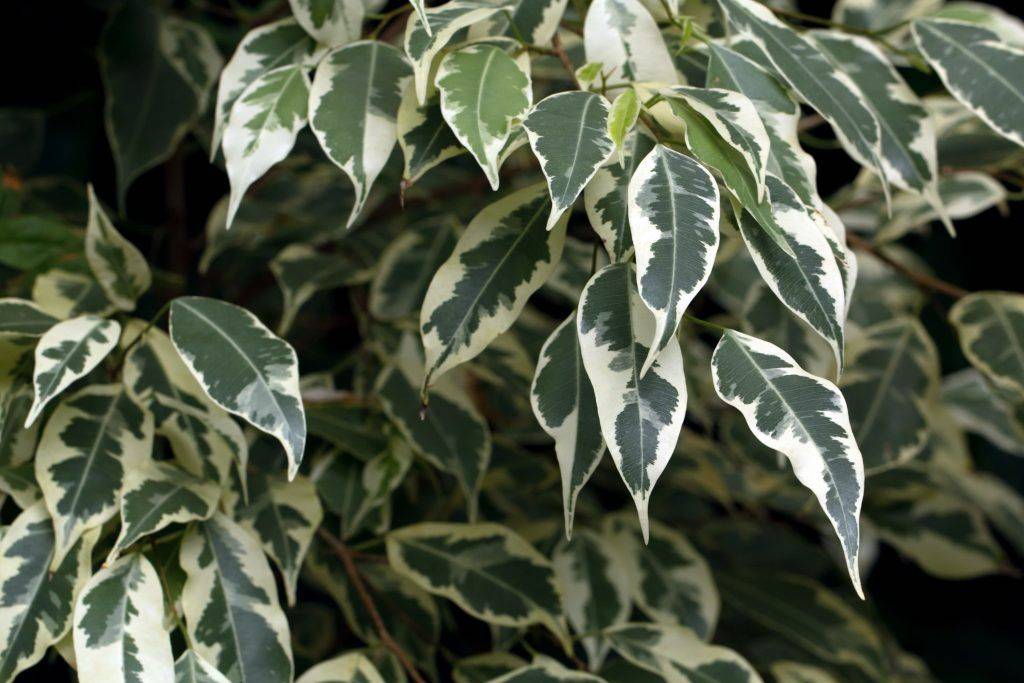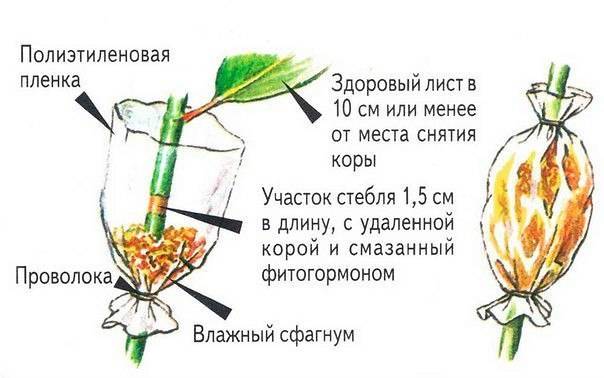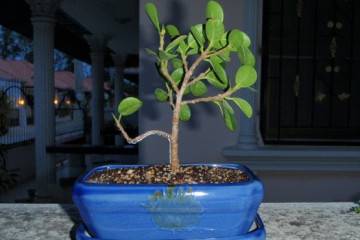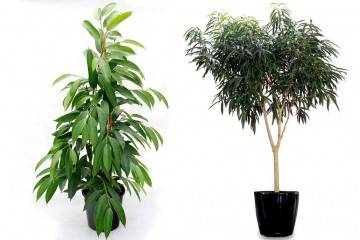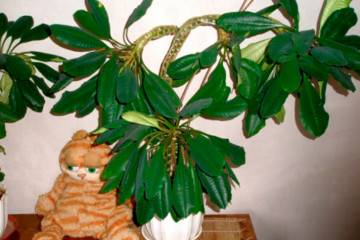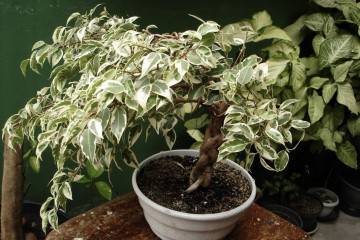Ficus Kinki - description and care of the house
Content:
Ficus Kinki is a decorative subspecies of Benjamin's ficus. It fascinates with variegated foliage and small size. Often serves as a decoration in residential and office premises.
Description of ficus Kinki
Ficus Kinki is an evergreen tree-like shrub. It is also called the ficus Green Kinky and Benj Kinki. Belongs to the Mulberry family. It is a small tree with a lignified bark of a brown-gray hue. The trunk is straight and smooth. The height of the shrub is up to 40 cm. It differs from its relatives in unusual leaves, they are narrow and multi-colored at the edges (light green, cream, light green, yellow). It is found wild in the tropical forests of Africa and Asia.
What varieties are popular
Among the popular varieties of ficus are:
- rubbery. The plant has large, shiny leaves that secrete a viscous sap. The rubber grade liquid is suitable for rubber production. It is the juice that gives the leaves their elasticity;
- variegated. The leaves are striking in their color, they can be green, white or pink. To make it decorative, several plants are planted in a pot, they intertwine with each other, giving the bush an unusual look;
- Benedict. The leaves are elongated, at the end the plate is pointed and resemble a sword. The trunk is large, lignified. Leaves can be solid or variegated;
- dwarf. Mostly grown in hanging pots. The branches are long and hang down to the bottom. It differs from other varieties with a crown, rather it resembles ampelous flowers;
- Bengal. It is large in size. Often found in greenhouses and large houses. It is rarely grown in the apartment.
Healing properties
Ficus Kinky is often used in folk medicine. Decoctions, juices and tinctures are made from the leaves. A fresh leaf is often applied to calluses, boils, and edema. Tinctures are used for joint diseases, rinse their mouth with them. Ficus juice helps to get rid of hemorrhoids, heals skin diseases.
Briefly about the history of appearance
Ficus Benj Kinky is found on the territory of four continents (Asia, Australia, Africa and America). Archaeologists claim that they knew about the ficus since the time of the Egyptian pharaohs, or even earlier. The tombs are made of ficus.
Features of caring for a plant at home
Ficus is unpretentious in the apartment. Caring for ficus Kinki at home includes:
- watering;
- top dressing;
- transplant;
- compliance with the temperature regime;
- spraying and moisture;
- pruning.
Subject to simple rules, the plant will delight others with its beautiful foliage for many years.
Temperature
Ficus Green Kinky belongs to heat-loving plants and does not tolerate low temperatures. The optimum range is from 22 ° C to 27 ° C. In winter, the temperature should not be lower than 16 ° C.
Lighting
A flower needs a lot of light for normal growth and development. Lighting should be diffused, otherwise, if ultraviolet rays hit the sheet, burns will appear on the sheet. If there is not enough light, the bush stops growing.
Watering
It is worthwhile to approach the watering procedure carefully. Excess moisture in the soil leads to rotting of the root system, and drying out leads to the death of the flower. Watering the plant is necessary as the soil dries out. Water is poured either under the root or into a pan. It is recommended to use settled or melt water.
Spraying and moisture
The plant prefers moist air. If the room is too hot, the plant must be sprayed. It is also necessary to humidify the air during the heating season in winter. To maintain moisture, you can put a container of water near the flowerpot. Special devices can be used as a humidifier.
Priming
Ficus Kinki prefers nutritious and loose soil. But it is better to use a ready-made substrate for palms or mulberries.
You can prepare the soil for ficus yourself, for this you will need:
- sod soil;
- humus;
- coarse river sand;
- peat.
All components are mixed in equal proportions. There must be a drainage layer at the bottom of the pot.
Top dressing
The tree needs constant feeding. This is necessary for normal growth and development.
Fertilizers are applied in spring according to the following scheme:
- 1 week - mineral fertilizers;
- 2 week - break;
- 3 week - organic fertilizers;
- 4 week - break.
This scheme is repeated until the onset of winter. The flower needs some rest during the winter months.
Features of winter care
In winter, the plant goes into hibernation. The temperature drops to 16 ° С, the air humidity - up to 50%. Watering is reduced. It is necessary to moisten the soil when the top layer of the earth dries out. You can check this with your finger.
Pruning and shaping the crown
Pruning is carried out once a year, there is no strict need for this. The procedure is needed to form the crown. This is best done in February or March. During pruning, the side shoots are shortened. Those branches on which there are lateral leaves are pruned. Also, shoots are cut, which are bent inward. Pruning allows you to remove those parts of the branches that do not fit into the shape of the plant.
The procedure is carried out with a sharp knife or scissors. Before starting the process, the tool should be wiped with alcohol. Do not cut many branches at a time. It is recommended to take breaks of up to 7 days. During this time, the tree will have time to move away from stress. In an adult plant, shoots are cut to 12 cm.
Reproduction of ficus
You can increase the population of indoor flowers in one of three ways.
Seed propagation
The seed method is a rather laborious method. Sowing of seeds is carried out in February. This requires:
- Soak seeds for 24 hours.
- Fill the pot with soil two-thirds.
- Place seeds in small holes and sprinkle with soil.
- Cover the container with seedlings with foil.
- Ventilate and moisturize once a day.
- After the appearance of the first leaves, the bushes must be planted in separate containers.
Rooting cuttings
Cuttings are carried out at any time of the year. A shoot is cut from the ficus (up to 12 cm long), it should have from two or more leaves. The cut branch is placed in a solution of potassium permanganate for 6 hours, after which the cutting is immersed in a container with clean water. As soon as the sprout takes root, it is planted in a pot.
Ficus can also be rooted in the ground, it is much more difficult, but at the same time the root system will be stronger. To do this, the cuttings are placed in water for a couple of hours, then in a pot with soil. After the cutting has grown up, it is transplanted into a larger container.
Air layering
To root the ficus with air layers, a small area up to 6 cm high must be cleaned on a branch. Activated carbon must be applied to the cleaned area and the treated branch must be wrapped with foil. Place soil or moss inside, then tie it with rope. You should get a small keg. A small hole should be left on top, the process should be attached to a stick and inserted into the pot to the flower. Water the plant through the top hole. A month later, the first roots appear on the handle. Once this has happened, the cutting should be cut at an angle and planted in a new pot.
Why does the ficus shed its leaves
When growing ficus Kinki, growers often face the following problems:
- sheds leaves;
- leaves turn pale;
- leaves turn yellow and dry;
- the lower leaves fall off.
Similar reasons are associated with improper care. The deciduous plate deforms and dries due to the dry air in the house. Leaves turn pale and fall off due to too high temperature. Abundant foliage discharge is the result of a flower being in a draft and in a cold room. Leaves grow dull due to lack of minerals.
With poor maintenance, the flower can get sick:
- gray rot;
- spotted.
And also get infected:
- spider mites.
- aphids.
You can get rid of ailments and insects with the help of pesticides.
Signs and superstitions
There are many signs and superstitions associated with ficus. According to them, the plant brings well-being to the house. If you give a tree to a young couple, then the girl will soon become pregnant, and the plant itself will protect and protect the child.
Ficus Kinki is an excellent ornamental plant that is used for landscaping apartments or offices. If properly cared for, it will delight you with beautiful variegated leaves for a long time.

